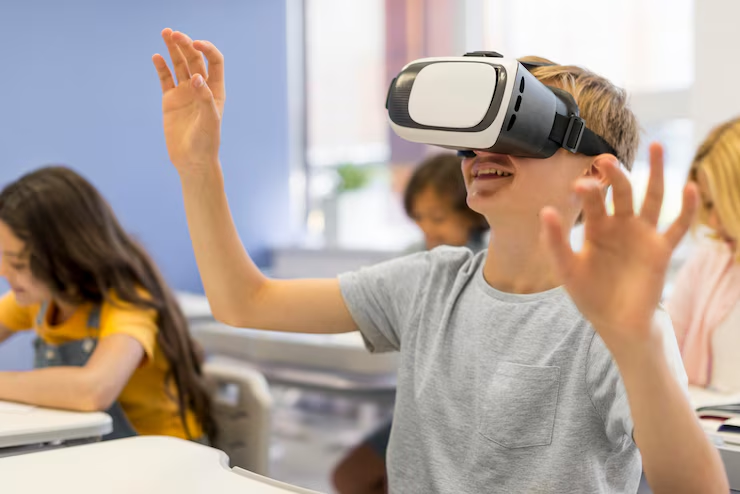Virtual reality classrooms in schools are transforming how students learn by immersing them in interactive, 3D environments. From exploring the solar system to walking through ancient civilizations, VR makes learning vivid, memorable, and deeply engaging.
At Apply Adviser, we believe technology should enhance education, not replace it. That’s why we’re spotlighting how virtual reality is redefining the traditional classroom, making abstract concepts real and sparking genuine curiosity among students.
What Are Virtual Reality Classrooms?
A virtual reality classroom is an immersive educational environment where students learn through VR headsets or simulators. These classrooms combine real-time instruction with fully interactive 3D visuals. Students can explore subjects hands-on like diving into the human body, visiting a volcano, or navigating historical events.
Benefits of Virtual Reality in Schools
1. Makes Learning Experiential
VR turns passive learning into active participation. Students don’t just read they experience the subject.
2. Enhances Retention and Engagement
Immersive environments help boost memory and attention span. Topics become easier to understand and harder to forget.
3. Safe Exploration of Risky Scenarios
Students can explore dangerous or distant places like space missions or chemical reactions without real-world risks.
4. Personalized and Inclusive Education
VR adapts to individual learning speeds, making it perfect for special needs students or those struggling with conventional methods.
5. Encourages Collaboration and Creativity
Virtual environments often include collaborative tasks, allowing students to work together and problem-solve creatively.
Subjects That Benefit Most from VR Classrooms
Science: Conduct experiments, study anatomy, or explore ecosystems in 3D.
History: Walk through ancient Rome or witness historic battles firsthand.
Geography: Navigate global landscapes and climates in real time.
Art & Design: Create and manipulate 3D models in a virtual studio.
STEM Labs: Code and simulate robotics or engineering projects virtually.
Challenges and Solutions
Cost and Infrastructure
VR hardware can be expensive, but affordable options like Google Cardboard and shared devices are closing the gap.
Training for Educators
Teachers need training to use VR tools effectively. Many edtech companies now offer onboarding programs and support.
Content Development
Customized curriculum-based VR content is still developing, but partnerships with edtech firms are solving this issue quickly.
The Future of Virtual Classrooms
The integration of virtual reality classrooms in schools is only going to deepen. With AI, real-time feedback, and cloud connectivity, future VR classrooms will be smarter, more responsive, and widely accessible. Schools embracing VR today are preparing students for tomorrow’s world technologically advanced, interactive, and globally connected.
FAQs
Q1. What equipment is needed for a VR classroom?
A: Schools typically need VR headsets, a stable internet connection, VR-compatible software, and trained educators.
Q2. Is VR safe for children to use regularly?
A: Yes, when used with breaks and age-appropriate content. Most platforms follow safety guidelines for screen time and motion sensitivity.
Q3. Can VR replace traditional teaching methods?
A: VR complements, not replaces, traditional teaching. It adds depth and interaction to core educational practices.
Q4. Are there free or low-cost VR options for schools?
A: Yes, platforms like Google Expeditions and Oculus Education offer budget-friendly or even free educational content.
Q5. How soon can a school implement a VR program?
A: Depending on budget and training, schools can begin small-scale integration in a matter of weeks with basic VR kits.
Conclusion
Virtual reality classrooms in schools are not just a trend—they’re a breakthrough in how knowledge is delivered and absorbed. At Apply Adviser, we advocate for learning that inspires and evolves with the times. VR classrooms offer an exciting glimpse into the future of education, one where learning is limitless, engaging, and inclusive for every student.




